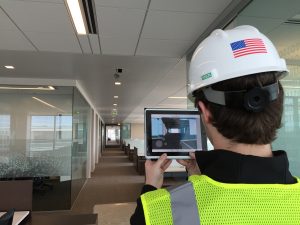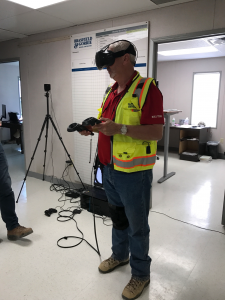Six Steps to Successfully Implement Innovation- and Construction-Related Technologies
January 14, 2019
I firmly believe that there is no better time to be involved in the construction industry than right now. With the demand for construction-related tasks on the rise, there has never been a greater need to implement new technologies, decrease waste, and increase productivity. This can be a daunting challenge given the current pressures already on our existing project teams. I have learned many lessons along the way, and I want to share six steps that have enabled us to successfully implement innovation- and construction-related technologies and ensure that our company remains competitive.
1. Adopt a vision.
Construction companies must establish a vision and direction in which they want to proceed into this ever-changing marketplace. This vision needs to remain flexible, but it must unify the team and paint a clear picture of what the company wants to accomplish. The daily barrage of new technology can distract and sometimes lead a company off course. Technology must be applied in a manner that can be adopted and understood by the end user. If a company and its employees are not in sync with a direction, the implementation of technology can be a detriment to that organization.
2. Create partnerships.
It is important to establish groups within the industry that are facing the same challenges. Generally, we are all trying to solve the same problems, so it’s valuable to build relationships to receive feedback and share ideas. Industry trade groups are great places to gain collective knowledge. User groups established by technology companies can also provide helpful forums for users to learn from one another. Partnerships such as these will ensure that your company’s vision aligns with a majority of the industry, allowing you to focus on implementation and productivity. Certain groups do need to be focused on the “leading edge” of technology, but for the most part, establishing great relationships will give you the perspective you need to stay competitive.

3. Re-establish your vantage point.
I once had a pastor tell me, “You need to remove yourself from the situation so that you can see more clearly.” I think this advice applies to most situations in life. Elevating ourselves from our existing knowledge and perspectives helps us analyze situations with a fresh perspective. It is critical that we continually educate ourselves and look at the evolution of other industries and how they solve problems.
At Brasfield & Gorrie, we examined the automotive industry to understand communication around a 3D model. In construction, this process has been coined as building information modeling (BIM). Comparing our construction processes to the automotive industry’s processes, which had been refined for 15 years, allowed us to make better decisions.
We established our BIM process years ago, but it has taken time for our people to adapt to these new concepts. We didn’t immediately try to change our company and force a new direction; we set a vision and guided our objectives, strategies, and investments toward that direction. By studying the automotive industry, we were able to re-establish our vantage point to more clearly understand the direction in which we wanted to proceed.
4. Adopt BIM.
My time in the construction industry has been predominately centered around the use of BIM and prefabrication. BIM is a communication tool. After five or six years of trying to understand how to explain BIM, we simply define it as “simulating the construction activities on a jobsite in a virtual setting to increase communication among the entire team, including owners, architects, engineers, subcontractors, and other key stakeholders.” For us, BIM is a process that establishes one location for every jobsite where information is created, stored, and communicated.

Having a clear direction and strategy has allowed us to partner with software companies and impact the development of their products instead of purchasing technology that is not moving us in the right direction. Because of the adoption of BIM within our company, our vision has allowed us to invest in other areas of technology and develop teams to support them. A few of those technologies are laser scanning, robotic total stations, grade control, drones, AR/VR, and prefabrication. We have now established a process to create a virtual simulation well in advance of actual construction; our teams take advantage of the process by implementing the use of prefabrication and offsite construction. This makes us more competitive, allows us to better utilize our labor force across diverse markets, and keeps our people safer.
5. Hire the best people.
Our company’s founder, Miller Gorrie, has always believed the key to success is to “Hire the best people, and get out of their way.” That statement has never been more relevant. We must find ways to attract the brightest young people to the construction industry to help us solve new problems. We are competing against many exciting industries in today’s marketplace. We must embrace technology, allow younger generations to teach us new advancements, and provide others with opportunities to succeed.
6. Stay Educated.
What got you here today isn’t what will get you there tomorrow. We must constantly learn and educate ourselves on what technologies and industry improvements are being developed. There are various industry-related organizations that provide nationwide networks, as well as local chapters, of general contractors, specialty contracting firms, service providers, and suppliers. Connecting with partners and peers through membership in professional organizations is a great way to share knowledge and stay informed.
About the author
 Innovation & Operational Technology Director Russ Gibbs oversees Brasfield & Gorrie’s use of innovation- and construction-related technologies and helped establish the company’s Virtual Design and Construction (VD+C) group. He collects and shares knowledge about the innovative ideas and activities taking place around the company, and he works with all levels of Brasfield & Gorrie employees to understand their daily needs and to develop creative and innovative solutions to address them. Russ’s favorite part of construction is seeing an idea become a physical reality. He enjoys finding ways to improve processes and help individuals grow. Ultimately, Russ feels called to better others’ lives through his work.
Innovation & Operational Technology Director Russ Gibbs oversees Brasfield & Gorrie’s use of innovation- and construction-related technologies and helped establish the company’s Virtual Design and Construction (VD+C) group. He collects and shares knowledge about the innovative ideas and activities taking place around the company, and he works with all levels of Brasfield & Gorrie employees to understand their daily needs and to develop creative and innovative solutions to address them. Russ’s favorite part of construction is seeing an idea become a physical reality. He enjoys finding ways to improve processes and help individuals grow. Ultimately, Russ feels called to better others’ lives through his work.